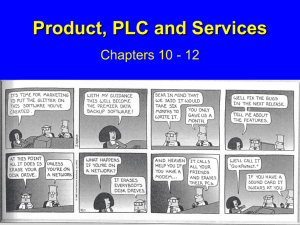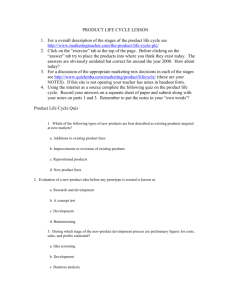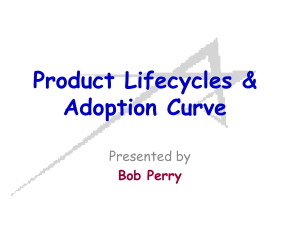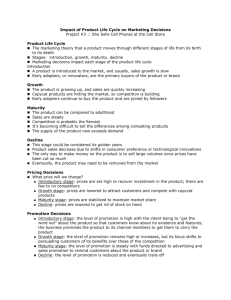Student Notes Pages Marketing Chapter 11: Developing and Managing Products Introduction
advertisement
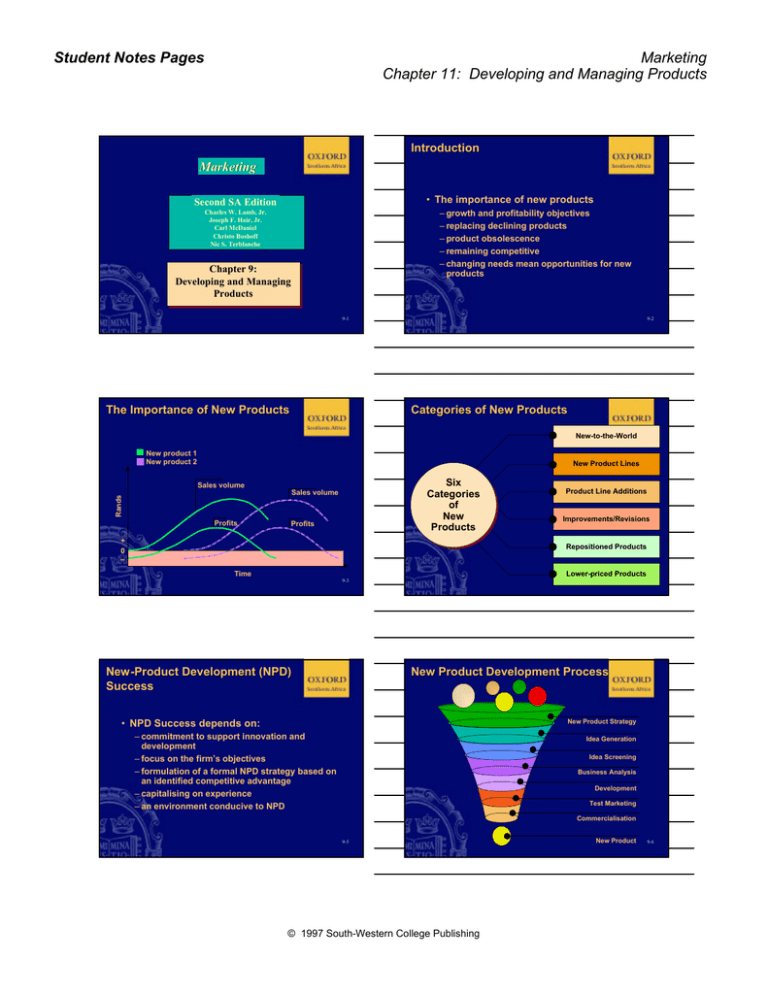
Student Notes Pages Marketing Chapter 11: Developing and Managing Products Introduction Marketing • The importance of new products Second SA Edition Charles W. Lamb, Jr. Joseph F. Hair, Jr. Carl McDaniel Christo Boshoff Nic S. Terblanche – growth and profitability objectives – replacing declining products – product obsolescence – remaining competitive – changing needs mean opportunities for new products Chapter Chapter 9: 9: Developing Developing and and Managing Managing Products Products 9-1 The Importance of New Products 9-2 Categories of New Products New-to-the-World New product 1 New product 2 New Product Lines Six Six Categories Categories of of New New Products Products Sales volume Rands Sales volume Profits Profits + 0 – Product Line Additions Improvements/Revisions Repositioned Products Time Lower-priced Products 9-3 NewNew-Product Development (NPD) Success 9-4 New Product Development Process New Product Strategy • NPD Success depends on: – commitment to support innovation and development – focus on the firm’s objectives – formulation of a formal NPD strategy based on an identified competitive advantage – capitalising on experience – an environment conducive to NPD Idea Generation Idea Screening Business Analysis Development Test Marketing Commercialisation 9-5 © 1997 South-Western College Publishing New Product 9-6 Student Notes Pages Marketing Chapter 11: Developing and Managing Products Sources of Ideas for New Products • • • • • • Stimulating NewNew-Product Ideas Customers Employees Distributors Competitors Research and Development Consultants • Attribute listing – analysis the features of existing products – modification possible? • Forced relationships – other products used in the same environment are assessed • Brainstorming – unlimited ways to solve a problem – no evaluation at first • Focus groups 9-7 IdeaIdea-screening 9-8 Concept Development and Testing • will it establish and sustain a competitive advantage? • will it contribute to the realisation of the firm’s business? Is it our business? • do we have the resources? • any legal implications? • what are the profitability prospects? • more thorough assessment against customer requirements – who will use the product? – what is the primary benefit? – when will it be used? 9-9 • verbal reactions to descriptions and visual representations eg. computer simulations • combining consumer needs and product features • solicit views of intermediaries 9-10 Test Marketing and Commercialisation Business Analysis and Development • Business Analysis • Test marketing – preliminary estimates of demand, costs, sales and profitability – assessment of competitive reaction – assessment of economic environment and business cycle – limited introduction to test market reaction and assess marketing strategy – selection of test market important – is expensive – can alert competitors • Development • Commercialisation – prototype – preliminary marketing strategy - 4Ps – technical feasibility - laboratory tests – the decision to to proceed with marketing a new product 9-11 © 1997 South-Western College Publishing 9-12 Student Notes Pages Marketing Chapter 11: Developing and Managing Products Why Some New Products Succeed Organization for New Product Development Failure Factors Success Factors Good match between product and market needs Adequate target market size Offers a clear, meaningful benefit Distinguishable from substitute products Offers unique, superior value Organisational commitment to new product development New Product Committee Poor match between product and market needs New Product Department Structures Structures Used Used to to Facilitate Facilitate New New Product Product Development Development Overestimation of market size Incorrect positioning Inappropriate price Inadequate distribution Venture Teams Simultaneous Product Development Poor promotion 9-13 The Product Life Cycle Growth Stage Maturity Stage The Product Life Cycle in Perspective Decline Stage Sales/Income Introductory Stage 9-14 Product Category Sales Product Category Profits 0 • It’s a tool to assist managers - it does not replace managerial judgement and decision-making • it suggests and not dictate strategies • the length of each stage depends on the product’s competitive advantage • the duration of each stage can be lengthened by means of product changes, new uses and re-positioning 9-15 Time Characteristics of the Introduction Stage 9-16 Characteristics of the Growth Stage • sales are slow and increasing slowly • often production and distribution problems • negative profitability due to high costs (incentives to both consumers and retailers, advertising costs, production problems) • no direct competition • promotion: primary demand • sales accelerate at first • modest profits late in this stage due to economies of scale and lower advertising costs • promotion: brand advertising • new competitors enter the market with “me-too” products • prices and industry sales begin to decline slightly late in this stage 9-17 © 1997 South-Western College Publishing 9-18 Student Notes Pages Marketing Chapter 11: Developing and Managing Products Characteristics of the Maturity Stage Characteristics of the Decline Stage • can be sub-divided into – growth, stable and decaying maturity • • • • • • longest stage sales increase at a decreasing rate market reaches saturation many “me-too’s” drop out intensely competitive often price wars as competitive advantage has been eroded 9-19 Strategies during the Introduction Stage • • • • • long-run drop in sales as more and more consumer switch to new products • only the strongest brands survive • rate of decline determined by: – technological advances – shifts in consumer preferences – intensity of competition 9-20 Strategies during the Growth Stage • market: monopolistic competition or oligopoly • objective: innovators to buy again, attract new buyers • slight lowering of price: raise barriers to entry • improve quality, add new features • line extensions • selective expansion of distribution • promotion: from awareness to brand insistence market: monopoly (no direct competitors) objective: encourage trial selective distribution: special attention price discretion – rapid skimming, slow skimming, rapidpenetration, slow-penetration • promotion: primary demand, focus on advantages and benefits 9-21 Strategies during the Decline Stage Strategies during the Maturity Stage • • • • • • • • 9-22 • market: many products/brands drop out • sharp focus on limiting expenditure • unprofitable models, brands and retail outlets dropped • three options: market: pure competition objective: increase market share find new uses, niche markets lower prices to reach price sensitive buyers develop new distribution channels add new ingredients or features improve quality or add guarantee re-position the product – hang in: chance of revival through improved marketing – withdraw – harvest: retain product but little or no marketing expenditure - target only the most loyal 9-23 © 1997 South-Western College Publishing 9-24 Student Notes Pages Marketing Chapter 11: Developing and Managing Products Adopters’ Adopters’ Categories The Diffusion Process Relationship of the Diffusion Process to the Product Life Cycle ADOPTERS’ CATEGORIES BASED ON INNOVATIVENESS Cumulative Percentage of Adoption Percentage of Adopters Introduction Growth Product life cycle curve 90 80 70 Early majority 60 Late majority 50 Early adopters 40 30 Innovators Laggards 20 Early Innovators Adopters 13.5% 2.5% Early Majority 34% Late Majority 34% Laggards 16% Time Decline Maturity 100 Diffusion curve 10 0 9-25 Rate of Adoption Time of Adoption of Innovations 9-26 Marketing Implications of Adoption Complexity • Two types of communication aid adoption Compatibility Characteristics Characteristics Affecting Affecting New New Product Product Diffusion Diffusion – word-of-mouth » opinion leaders important – marketer-to-consumer Relative Advantage » different appeals for early adopters, early majority, late majority, etc Observability Trialability 9-27 © 1997 South-Western College Publishing 9-28

